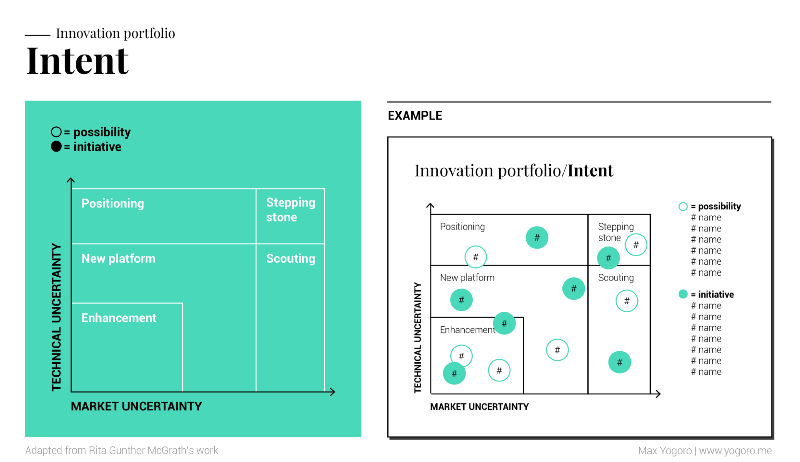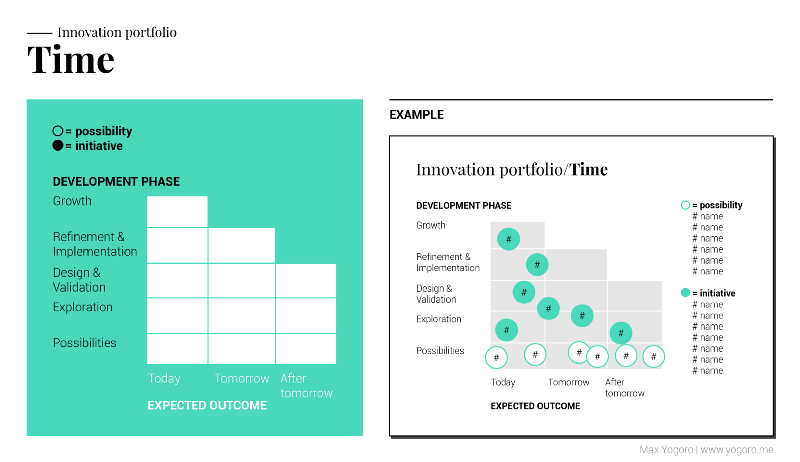In every sector, it’s possible to notice growing efforts towards innovation. More and more organizations do not take their market and own relevance for granted, and realize that some [widely applied] strategies to maintain and grow their businesses [like plain price competition, and aggressive portfolio expansion, among others] may incubate serious near and long term fragilities.
These organizations gradually perceive that designing and redesigning their offerings and themselves paves the way into continuous [dynamic] competitive advantage, creates higher value, builds better branding, and makes them more attractive to the best collaborators. They interpret innovation as a way of being, not a silver bullet; as a habit, not an act.
While this understanding flourishes and the number of design and redesign initiatives increases, my experience with organizations from different industries, nature, and sizes shows that the majority of them loosely drifts to choose which of these initiatives to pursue. In an endless sea of new opportunities, challenges and methods, they are guided by no compasses.
The inherent unpredictability and uncertainties of these initiatives may seem too cloudy to be dealt with, and they consequently suffer from some [if not all] of these conditions:
· they are treated as standalone projects, not as a piece of a wider strategy
· their relevance is highly questioned due to their level of uncertainty [and internal resources tend to gravitate more predictable initiatives]
· their lack of clear goals and shared guiding principles makes them harder to be managed and understood
· they help the organization to learn about the opportunity/challenge at hand, but not about the organization’s own approach to innovation
· they do not support each other and do not maximize an organization’s total investment in innovation
No wonder, so many organizations would benefit from developing a much clearer awareness on:
· which opportunities and challenges to explore
· which methods/approaches [human-centered design, co-creation, analytical problem solving, …] to apply to each opportunity/challenge
· which partners/consultancies to collaborate with
· where and how to allocate resources
· how to develop projects which are swamped with uncertainty
· how to transform their culture and structure to promote innovation
They are left alone with these question and, more often than not, start to find answers the hard way, through a lot of wasted energy, time, and money. I’ve been forging a model to support clients and partners in having more productive and thoughtful conversations and decisions towards their innovation/design/redesign efforts.
As obvious as it may sound… a portfolio perspective is required to bring strategic thinking into your innovation initiatives. The goal here is neither to point out which kind of innovation your organization should pursue, nor to discuss how to solve any innovation challenge, but to throw light on how to interpret your projects as a whole, and act on them.
Being intentional with your innovation portfolio will help you to:
· better allocate your energy and resources
· direct your portfolio according to your overall strategy
· find opportunities to combine efforts and outcomes
· periodic reviews
· avoid plain ‘trial and error’ approach, blindly following fads, and other overly loose efforts
It all starts by getting your innovation/design/redesign initiatives [at least partially] together on the table to further reflections, comparisons, and decisions. Knowing that the space [opportunities and challenges] for innovation take many forms, the following frameworks and insights were designed to be useful and adaptable to a variety of organizations and scenarios.
UNDERSTANDING YOUR INNOVATION PORTFOLIO
Your innovation portfolio is made of opportunities and challenges to which you desire to build a novel and valuable concept/solution. It is expected that some of these opportunities and challenges are still untapped, as possibilities, and also that you have been working in some already, your initiatives. For your innovation portfolio, let us consider both.
Three frameworks will help you to understand and balance underlying strategies for your possibilities and initiatives [Intent], their core arena [Focus], and their development phase with expected time frame [Time]. Some insights are highlighted to each of these frameworks but they are, above all, tools to ignite more valuable reflections and decisions. I strongly recommend that you use and discuss them with others.
Intent
This framework is adapted from Rita Gunther McGrath’s work [The Entrepreneurial Mindset]. It organizes your possibilities and initiatives into two axes:
· Technical uncertainty: ‘Is it feasible?’, ‘Is it legal?’, ‘Which solution is technically preferable?’
· Market uncertainty: ‘Is it desirable?’, ‘Will people and the market appreciate it?’

From it, the following categories will emerge:
Enhancement [low technical uncertainty + low market uncertainty]: improves your current offerings. E.g. a more efficient product; a faster customer service
New platform [mid technical uncertainty + mid market uncertainty]: opens new directions and usually requires a higher investment than Enhancements. E.g. a solar energy business for a hydropower energy producer; a hardware device for a software company [Spectacles from Snap Inc. https://www.spectacles.com/]
Positioning [high technical uncertainty + low-mid market uncertainty]: there is some general agreement that the market will move in a specific direction but there is no definite technical answer for the opportunity/challenge. It requires multiple minor investments until a path becomes clearer. E.g. IBM simultaneously investing in different technologies to overcome silicon’s limits in the semiconductor industry [knowing that a major part of these technologies is likely to fade in the future]; what happened to the ‘Blue-ray vs HD-DVD’ competition for the new standard [over the previous technology, DVD] around 2007
Scouting [low-mid technical uncertainty + high market uncertainty]: technology is ready [or almost] but there is no agreement about the market acceptance. It requires prototypes and small-scale experiments to test or educate the market, before bigger investments. E.g. smartphone controlled household appliances; under-the-skin devices [http://actu.epfl.ch/news/a-chip-placed-under-the-skin-for-more-precise-medi/]; 3D-printed meat [http://www.bbc.com/news/technology-20972018]
Stepping stone [high technical uncertainty + high market uncertainty]: vision-driven bets for the long run. It requires continuous small investments over a long period of conceptual and technological exploration. E.g. applications of artificial intelligence, nanotechnology, and advanced robotics
INSIGHTS
· The higher the uncertainty the higher the required effort and investment in research and experimentation
· A percentage of your budget can be preset to each category, so one kind of initiative does not destroy or lose space to another. E.g. Enhancement 40%, New platform 30%, Positioning 12,5%, Scouting 12,5%, Stepping stones 5%
· Possibilities and initiatives with lower uncertainty tend to be more reliable in the short term, the ones of higher uncertainty tend to be essential for future revenue
Focus
This one helps you to balance offering-oriented and organization-oriented transformations.
At the Frontstage, you have Product & Service [your offerings], Experience [your touchpoints with customers and stakeholders], and Business Model [your approach to generating revenue and deliver value]
At the Backstage, you have Strategy [where you aim to go], Process [activities that you do], and Structure [tangible and intangible things you can access and use, and how you are internally organized]

INSIGHTS
· From the harder to the easier to change, you could consider: Business Model >> Experience >> Product & Service; and Structure >> Process >> Strategy
· The more complex the change the more it impacts the front and the backstage
· The farther from the core the more new competencies are required
Time
This one gives you an overview of the current development phase of your initiatives and the term of their expected impact/outcome.
As Development Phases, you have Possibilities [untapped opportunities and challenges], Exploration [deep understanding, research, and discovery; particularly relevant for higher levels of uncertainty], Design & Validation [ideation, prototyping, and testing], Refinement & Implementation [adjustment and production], and Growth [volume escalation].
As Terms for Expected Impact/Outcome, you have Today [until ±3 years from now], Tomorrow [from ±3 to ±6 years from now], and After Tomorrow [after ±6 years from now].

INSIGHTS
· The farther the expected impact/outcome is in the future, the higher the uncertainty, and the more small scale research and experimentation make sense [instead of big, bold, expensive projects]
· A continuous and balanced pipeline along the development phases promotes a consistent pace of transformation
· Fast pacing industries require a fast circulation of initiatives from Exploration to Implementation
What now?
With these frameworks in sight, you are able to comprehend where your innovation/design/redesign initiatives are taking your organization. You can evaluate if your efforts match your overall strategy, your context, and the relevant external transformations/trends. You can prioritize possibilities and initiatives, and evolve conversations with those whose support and participation are crucial.
What next?
The next article explores how to deal with new initiatives, how to prepare and guide their development. Coming soon. :)
